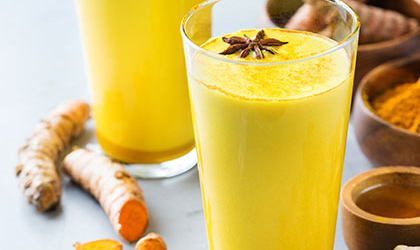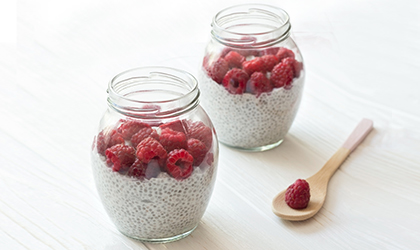
At its core, inflammation is a complex biological response to injury or sickness. It’s a cornerstone of the body’s healing process – a benevolent force evolved to protect us from germs, traumas and poisons. And yet, inflammation is so powerful that it can kickstart problems if it becomes chronic.
Research suggests low-grade, inappropriate inflammation is the root cause of many diseases (1). In the words of Professor Tim Spector, a medical doctor and one of the top 100 most cited scientists, ‘nearly every disease is associated with some disorder of inflammation and considered a key part of ageing’ (2).
Fortunately, there are many ways to reduce inflammation – and using nutrition is one of them.
Dietary interventions to reduce inflammation
Food has the power to cause, prevent, and manage inflammation. There’s no specific ‘anti-inflammatory diet’ per se. Ultimately, it comes down to living like our ancestors: not eating too much and avoiding anything we don’t recognise as ‘food’.
Reduce ultra-processed foods
Ultra-processed foods are ubiquitous nowadays. But we haven’t evolved to eat refined, flour-derived products. The body regards these so-called foods as ‘foreign’ – similar to invading pathogens – activating the immune system and causing inflammation. Reducing your intake of highly refined, processed foods is an important and necessary step to lower inflammatory markers.
Focus on a wholefood diet
Unlike ultra-processed products, whole foods are packed with anti-inflammatory properties. Eating a diverse range of plant foods, like vegetables, whole grains, legumes, nuts, seeds, and beans, as well as healthy fats and lean proteins, including oily fish and poultry, can help restore balance in the body. A varied, minimally processed diet may also support weight and blood sugar management, reducing inflammation even more.
The traditional Mediterranean diet deserves a special mention here. Studies report that a plant-focused Mediterranean-style diet – rich in whole grains, vegetables, fruits, beans, and nuts – may reduce inflammation and prevent chronic health conditions (3).
Feed your gut
Scientists are now beginning to recognise that our bustling community of gut microbes plays a critical role in immune function and inflammation. Gut imbalances – or dysbiosis – are known to increase inflammatory markers, so looking after your gut should always be a priority when tackling inflammation (4).
Eating 30 different plant foods – fruit, vegetables, nuts, seeds, whole grains, legumes and beans – weekly is one of the best ways to cultivate an anti-inflammatory gut ecosystem (5). These foods are rich in polyphenols and fibre, which feed your hungry gut microbes. Including more fermented foods, like kefir and kombucha, as well as live cultures, can support gut health (6).
Try intermittent fasting
Intermittent fasting imitates the sporadic availability of food that would have been commonplace for much of human history. Fasting gives your body the time it needs to repair itself – and that’s why emerging research suggests it may improve inflammatory markers (7).
Fasting tips
-
Aim for an 8-12 hour eating window daily –11 am – 8 pm, for instance.
-
Ensure your feeding window is 3-4 hours before bed to avoid disrupting sleep.
-
Fasting might not be for everyone. Try a gradual approach and monitor how you feel or consult your healthcare advisor before giving it a try.
Balance blood sugar
Poor blood sugar regulation and inflammation go hand in hand. Aside from eating more complex carbohydrates (think quinoa instead of white rice), reducing your sugar intake, and adding more dietary fibre – abundant in all plant foods – you may want to increase your chromium intake, which supports blood glucose maintenance. Brazil nuts, tomatoes, and egg yolks are great sources of chromium.
Research also suggests the spice, cinnamon, may play a role in normal blood sugar management (8).
Choose organic where possible
Buying organic produce, where possible, can help limit your pesticide exposure and reduce low-grade inflammation, which has been linked to higher risks of certain health conditions (9).
-
Prioritise low-pesticide foods: Typically, citrus fruits, berries, and leafy greens have multiple pesticide residues, while avocados, mushrooms, and carrots have the lowest amounts.
-
Choose canned and frozen: Canned and frozen organic options are often cheaper than fresh produce and retain their nutritional properties.
-
Staples first: Think about the plant foods you eat most often and consider switching those to organic first.
-
Explore alternatives: Farmers markets, vegetable boxes, and independent greengrocers are great ways to find organic produce.
Always wash your produce
Washing your fruit and vegetables thoroughly before eating is vital to reduce pesticide exposure. If you have more time, you could soak your produce in apple cider vinegar for 20 minutes. Aim for 1 part vinegar to 4 parts water.
Think about storage
You may wish to use glass, bamboo or BPA-free (an endocrine-disrupting compound found in some plastics) storage containers to prevent plasticisers from leaching into your leftovers. And where possible ditch the single-use water bottles, too. Choose reusable stainless steel instead.
Up your omega-3 intake
Some evidence suggests omega-3 fatty acids, EPA and DHA, may reduce inflammatory markers in the body (10). Make a conscious effort to eat a mixture of foods high in omega-3s, including mackerel, salmon, chia seeds, flaxseeds, and walnuts. You may also want to take a quality fish oil supplement or vegan alternative derived from plant-based microalgae to buffer levels.
Sip green tea
Green tea has long been regarded as a ‘superfood’. Studies note its major component, epigallocatechin-3-gallate (EGCG) may lead to lower inflammatory markers (11). With that in mind, why not swap your normal ‘builders’ for green tea?
Incorporate immune-loving nutrients
Vitamin C and D3 play a critical role in immune function, making them important additions. You can find vitamin C in green, red, yellow, and orange fruits and vegetables, and vitamin D3 in oily fish, mushrooms (especially those left on a sunny windowsill!), and egg yolks. The body also naturally synthesises vitamin D3 when the skin is exposed to direct sunlight.
Add more spice
Aromatic and fragrant, turmeric, garlic, and ginger have been used in traditional preparations for years. These spices are rich in active compounds – including curcumin in turmeric and allicin in garlic – that may have anti-inflammatory properties, so use them liberally when cooking.
Increase berries
Berries are unusually rich in powerful antioxidant compounds called anthocyanidins, which help reduce free radical damage – a mechanism often implicated in inflammatory diseases. Raspberries, blueberries, blackberries, and cranberries are packed with goodness. Try to eat a serving every day.
Try PEA
PEA (Palmitoylethanolamide) is a type of fatty acid found in all cells, tissues and fluids Described as an endocannabinoid-like chemical, PEA is a well-researched alternative to CBD.
Your body increases its production of PEA when cells are damaged or threatened. However, in certain situations – when your body experiences chronic inflammation, for instance – the level of PEA in your cells drops (xiii). When this happens, you may want to up your intake.
You can find PEA in soya beans, peanuts, eggs, flaxseed and milk, as well as supplements.
Find more information
If you found this article on inflammation helpful, you can find further content on Nutrition Buzz. Alternatively, please get in touch with our team of expert Nutrition Advisors, who will be happy to help with any enquiries.
References:
-
Furman, D., Campisi, J., Verdin, E. et al. (2019) Chronic inflammation in the etiology of disease across the life span. Nat Med 25, 1822–1832.
-
The truth about inflammation: All you need to know about 2023’s hottest health topic, from causes to cures (2023) The Guardian. Available online: https://www.theguardian.com/lifeandstyle/2023/jun/27/the-truth-about-inflammation-all-you-need-to-know-about-2023s-hottest-health-topic-from-causes-to-cures
-
Gerber M, Hoffman R. (2015) The Mediterranean diet: health, science and society. Br J Nutr 113 Suppl 2: S4-10.
-
Bolte, L.A. et al. (2021) Long-term dietary patterns are associated with pro-inflammatory and anti-inflammatory features of the gut microbiome. Gut 70(7), 1287–1298.
-
Jones, P. (2023) Eating 30 plants per week: How to do it and why, Eating 30 Plants per Week: How To Do It and Why. Available online: https://joinzoe.com/learn/30-plants-per-week
-
Marco ML, Sanders ME, Gänzle M, Arrieta MC, Cotter PD, De Vuyst L, Hill C, Holzapfel W, Lebeer S, Merenstein D, Reid G, Wolfe BE, Hutkins R. (2021) The International Scientific Association for Probiotics and Prebiotics (ISAPP) consensus statement on fermented foods. Nat Rev Gastroenterol Hepatol. 18(3):196-208.
-
Aly SM. (2014) Role of intermittent fasting on improving health and reducing diseases. Int J Health Sci (Qassim). 8(3): V-VI.
-
Jarvill-Taylor KJ, Anderson RA, Graves DJ. (2001) A hydroxychalcone derived from cinnamon functions as a mimetic for insulin in 3T3-L1 adipocytes. J Am Coll Nutr. 20(4):327-36.
-
Yan, D., Zhang, Y., Liu, L. et al. (2016) Pesticide exposure and risk of Alzheimer’s disease: a systematic review and meta-analysis. Sci Rep 6, 32222.
-
Simopoulos AP. (2002) Omega-3 fatty acids in inflammation and autoimmune diseases. J Am Coll Nutr. 21(6):495-505.
-
Ohishi T, Goto S, Monira P, Isemura M, Nakamura Y. (2016) Anti-inflammatory Action of Green Tea. Antiinflamm Antiallergy Agents Med Chem. 15(2):74-90.
You Might Also Like

Olivia
Olivia Salter has always been an avid health nut. After graduating from the University of Bristol, she began working for a nutritional consultancy where she discovered her passion for all things wellness-related. There, she executed much of the company’s content marketing strategy and found her niche in health writing, publishing articles in Women’s Health, Mind Body Green, Thrive and Psychologies.
View More



